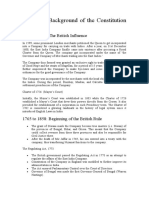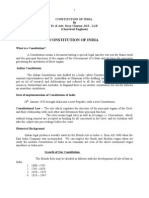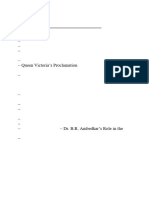0 ratings0% found this document useful (0 votes)
25 viewsModern History
Modern History
Uploaded by
nitindefence222The document discusses several important acts introduced by the British Parliament that regulated the administrative functions of the British East India Company in India. It outlines key aspects of acts like the Regulating Act of 1773, Pitt's India Act of 1784, the Charter Acts of 1793, 1813, 1833 and 1853.
Copyright:
© All Rights Reserved
Available Formats
Download as PDF, TXT or read online from Scribd
Modern History
Modern History
Uploaded by
nitindefence2220 ratings0% found this document useful (0 votes)
25 views13 pagesThe document discusses several important acts introduced by the British Parliament that regulated the administrative functions of the British East India Company in India. It outlines key aspects of acts like the Regulating Act of 1773, Pitt's India Act of 1784, the Charter Acts of 1793, 1813, 1833 and 1853.
Copyright
© © All Rights Reserved
Available Formats
PDF, TXT or read online from Scribd
Share this document
Did you find this document useful?
Is this content inappropriate?
The document discusses several important acts introduced by the British Parliament that regulated the administrative functions of the British East India Company in India. It outlines key aspects of acts like the Regulating Act of 1773, Pitt's India Act of 1784, the Charter Acts of 1793, 1813, 1833 and 1853.
Copyright:
© All Rights Reserved
Available Formats
Download as PDF, TXT or read online from Scribd
Download as pdf or txt
0 ratings0% found this document useful (0 votes)
25 views13 pagesModern History
Modern History
Uploaded by
nitindefence222The document discusses several important acts introduced by the British Parliament that regulated the administrative functions of the British East India Company in India. It outlines key aspects of acts like the Regulating Act of 1773, Pitt's India Act of 1784, the Charter Acts of 1793, 1813, 1833 and 1853.
Copyright:
© All Rights Reserved
Available Formats
Download as PDF, TXT or read online from Scribd
Download as pdf or txt
You are on page 1of 13
Administrative functions of British E.I.C.
in India IMPORTANT ACTS
INTRODUCED BY THE BRITISH
PARLIAMENT
Regulating Act of 1773
Pitt’s India Act of 1784
Charter Act of 1793
Charter Act of 1813
Charter Act of 1833
Regulating Act of 1773
1. Made the Governors of Madras and Bombay Presidencies subordinate to the Governor-General of
Bengal , unlike earlier the three Presidencies were independent of one another.
2. Govt. Headed by a Governor-General in Bengal and four councilors , having the supervisory
authority over the Presidencies of Bombay and Madras.
3. Act also recognized the right of Parliament to regulate the civil, military and revenue affairs of the
Company’s territories in India.
4. First step taken by the British government to control and regulate the affairs of the E.I.C. in India.
5. It recognized for the first-time, the politics and Administrative functions of the Company.
6. Laid the foundation of central administration in India.
7. Designated the Governor of Bengal as the Governor-General of Bengal and created an executive
council of four members to assist him . First such governor was Lord Warren hastings.
8. Establishment of S.C. at Calcutta (1774) comprising one C.J. and three other judges, with Sir Eliza
Empe its C.J.
9. Prohibited the servants of the Company from engaging in any private trade or accepting presents
and bribe from the natives.
10. Strengthened the control of the govt. Over the Company by requiring the court of directors
(governing body of the Company) to report on its revenue, civil military affairs of India.
PITT’S INDIA ACT ,1784
1.Extended the control of the British government over
the Company’s affairs and its administration in India.
2.Act designated between the commercial and political
functions of the Company.
3.Established a board of Control to guide and control
the work of the Court of Directors and the govt. Of
India.
4.Empowered the Board of Control to supervise and
direct all operations of the British possessions in India
such as: The civil, the military and the revenues.
CHARTER ACT OF 1813
1.In Europe the spirit of laissez-faire and continental system of Bonaparte’s had
prohibited the import of British goods into the French allies in Europe, and as a
result of it the British traders and merchants suffered heavily.
2.Charter Act or 1813 sought to redress those grievances of the British traders and
merchants
3.Ended the trade monopoly of the British E.I.C. In India, except the Company’s
monopoly in trade with China and Tae.
4.Asserted the sovereignty of British Crown over the Company’s territories in India.
5.The Company’s rule was extended for another 20 years’ period .
6.Powers of Board of Control were further extended.
7.Act granted permission to the persons who wished to go to India for promoting
moral and religious improvements- Christian missionaries.
8.Act regulated the Company’s territorial revenue and commercial profits. It was
asked to keep its territorial commercial accounts separate.
9.It was also provisioned that the company should invest ₹ 1 lakh every year on
education of Indians .
10.Empowered the local govts. In India to improve taxes on persons and to punish
CHARTER ACT OF 1833
1.Paved the way to reconstitute the administration on a new model to give it an all India character .
Thus , the act was the final step toward centralization in British India.
2.It attempted to introduce a system of open competitions for the selection of civil servants.
3.Company’s monopoly over trade with China and in tea was ended .
4.Legalized the British colonization of India. The E.I.C. from a commercial to an administrative body.
5.Company’s territories in India were held by the govt “ in trust for her Majesty , his heirs and
successors “
6.Governor-General of Bengal as the Governor-General of India and vested in him all civil and military
powers.
7.Lord William Bentinck as the first Governor-General of India had legislative powers over the entire
British India. Thus , governos of Bombay and Madras lost their legislative powers.
8.Laws made under the previous acts were called “ Regulations “ while laws made under this act
were called “Acts”.
9.Governor-General’s govt was called “ government of India ” and the councils was called “Indian
council “
10.Indian law commission(1834) was established to codify all Indian laws . The first law Commission
had Lord Macauley as its chairman. NOTE- The first Commission of independent India ( chairman
M.C. Setalwad) (Neither a constitutional body nor a statutory body) was established in 1955 for a
three-years’ term . Since then 22 more commissions have been established. The last chairman was
retired S.C. judge Mr. Rituraj Awasthi
CHARTER ACT OF 1853
1.The last of the series of charter acts passed by The British Participant between 1793 and 1853.
2.Act empowered the British EI.C. to retain the territories and the revenues in India in trust for the
Crown not for any specified period , unlike the previous charters acts of 1793, 1813,and 1833 which
renewed the charter for 20 years.
3.Separated the legislative and executive functions of the gov Gen’s councils for the first time.
4.Provided for the abolition of six new members called legislative councilors to the council (12 in
total).
5.This legislative wing of the council functioned as a” mini Parliament “ , adopting the same
procedures as British Parliament.
6.Law member (fourth member) became a full member with the right to vote.
7.Introduced an open competition system of selection and recruitment of civil servants; thus ,it was
thrown open to the Indians too.
8.Led the appointment of Macaulay committee on the Indian Civil service 1854.
9.Number of Board pf director’s was reduced from 24 to 18 out of which 6 were to be nominated by
the British Crown.
10.Act also introduced, local representation in the Indian (central) legislative council for the first
time.
THE CRON RULE : 1858 – 1947
Govt of India Act 1858
Indian council act 1861
Indian council act 1892
Indian council act 1909
Indian council act 1919
Govt of India Act 1935
Govt of India Act 1947
GOVERNMENT OF INDIA ACT 1858
1.Known as the Act of good government of India, it abolished the E.I.C.
and transferred the powers to the Crown
2. Rule of the Company ended and viceroy was the new designation of
the Governor-General of India : who was the direct representative of
the British Crown in India
3. Abolished the Board of Control and court of directors thus, ending
the double government.
4. Office of secretary of state for India Was created, who was member of
British cabinet responsible to the British govt.
5. The secretary Of state was to be assisted by a council of 15 members.
It was an advisory body with SoS being the chairman of the council.
6. Focused upon improving Administrative machinery (Governor-
General of India replaced by viceroy under the Crown) of India.
INDIAN COUNCIL ACT 1861
1.Provided for viceroy to nominate some Nominated Indians in the
extended legislative council .( BY 1862, Viceroy Canning nominated
three Indians in the Legislative Council.) 1. RAJA OF BANARAS 2.
MAHARJA OF PATIALA 3. SIR DINKAR RAO
2.THE Legislative powers of Bombay and Madras Presidencies were
restored.
3.It made provisions of formation of new legislative council (Upper
House ) for Bengal (formed in 1862), North Western Province (1886),
Punjab (1897).Presidencies of Bombay, Madras and Bengal had more
powers than this.
4.The Viceroy was empowered to issue an ordinance without the consent
of the legislative council in case of emergency. This ordinance was valid
till 6 months from the date of issue.
5.It recognized the portfolio system which was started by Lord canning
in 1859.
INDIAN COUNCIL ACT 1892
1. Additional non official members increased in central and provincial
and Legislative Councils. Thus Official majority was maintained .
2. Increases in the function of Legislative Councils: the power of
discussing Budget and addressing the questions to the executive.
3. Provided for the nomination of non official members of:- Central
Legislative Council- by the viceroy on the recommendation of the
provincial Legislative Council and Bengal chqmbers of commerce.
PROVINCIAL LEGISLATIVE COUNCILS- BY the Governor on the advice
of District Board, Municipalities, universities, Trade Associations,
Zamidars , and Chambers.
4. Word “ELECTION “ was nowhere mentioned but animated and indirect
election for the nominated members was introduced in this Act.
INDIAN COUNCIL ACT 1909 ( Marley Minto Reform)
1 Legislative Council was enlarged. In the Central Legislative council members were
increased from 16 to 60. In provincial it was not uniform in nature.
2. Cen Legs Council continued to have official majority; whereas Non-official majority
was allowed in the provincial Legislative council.
3. More powers were given to the Legislative Councils :- Members were allowed to
ask supplementary questions such as – 1. Voting for separate items on budget was
allowed
2. Budget as whole could still not be voted upon
4. Separate electorate for Muslim introduced. Only could vote for Muslim candidates.
5. Lord Minto became the father of Communal Electorate . Indians were allowed in the
executive councils of the viceroy for the first time. Satyendra pd Sinha was appointed
as a law member in th3 viceroy executive council.
6. Separate representation for presidency corporations, chamber of commerce ,
universities.
7. It was the first attempt to introduce Representative and Popular Elements in the
councils .councils were referred to as Legislative Councils for first time.
You might also like
- Active Math Workbook Stage 3Document228 pagesActive Math Workbook Stage 3Nelly Lam100% (1)
- Irish Center Ruling Dec. 2018Document13 pagesIrish Center Ruling Dec. 2018Daily FreemanNo ratings yet
- HISTORY AND EVOLUTION OF INDIAN CONSTITUTION NOTES 2 UNIT 2.Document19 pagesHISTORY AND EVOLUTION OF INDIAN CONSTITUTION NOTES 2 UNIT 2.mukeshbhatnagarbhatnagar1No ratings yet
- M.lakshmikant Chapter 1Document17 pagesM.lakshmikant Chapter 1Shivankar sukulNo ratings yet
- Constitutional Development of India 1773-1950Document6 pagesConstitutional Development of India 1773-1950SANTOSH CHAUHANNo ratings yet
- Value Addition Notes (History of Constitution Making) - PDF OnlyDocument8 pagesValue Addition Notes (History of Constitution Making) - PDF Onlymratyunjay baghelNo ratings yet
- Unit 4 HistoryDocument9 pagesUnit 4 Historyjyuvi360No ratings yet
- What Is Constitutional Development?Document6 pagesWhat Is Constitutional Development?smriti goelNo ratings yet
- Laxmikanth Summary - Constitution of India - Famous Books For UPSC Exam (Summary and Tests) PDF DownloadDocument16 pagesLaxmikanth Summary - Constitution of India - Famous Books For UPSC Exam (Summary and Tests) PDF Downloaddarshannn6429No ratings yet
- Ch-01 - Historical Background Polity UPSCDocument4 pagesCh-01 - Historical Background Polity UPSCDisha MantriNo ratings yet
- Framing of The Indian ConstitutionDocument7 pagesFraming of The Indian Constitutionprashant panwarNo ratings yet
- Constitutional Development Through Reasonable ReformsDocument12 pagesConstitutional Development Through Reasonable Reforms125087049No ratings yet
- Act 1833Document6 pagesAct 1833SurendraSinghRathoreChowk100% (1)
- History Units 1 5 Pages 1 15,22 58Document52 pagesHistory Units 1 5 Pages 1 15,22 58Aahana AcharyaNo ratings yet
- ConstitutionDocument10 pagesConstitutionNikhil ThakurNo ratings yet
- Pre Constitutional ActsDocument10 pagesPre Constitutional ActsFredrick Russel LionelNo ratings yet
- CH 2 Historical UnderpinningsDocument35 pagesCH 2 Historical UnderpinningsMonikaNo ratings yet
- Consti NotesDocument10 pagesConsti NotesPratiksha PraveenNo ratings yet
- Medieval HistoryDocument92 pagesMedieval HistoryAmbarish ShankarNo ratings yet
- Historical Background PolityDocument11 pagesHistorical Background Polityramsai14264No ratings yet
- Indian PolityDocument4 pagesIndian Polityfandufacts4No ratings yet
- Historical Background of The Constitution of IndiaDocument7 pagesHistorical Background of The Constitution of IndiaStaffy KaurNo ratings yet
- History and Development of The Constitution of IndiaDocument9 pagesHistory and Development of The Constitution of IndiaAnonymous uxd1ydNo ratings yet
- By Ankit Bajad SirDocument49 pagesBy Ankit Bajad SirMonalisha PattraNo ratings yet
- Law Commission, 1833 Act and 1861 ActDocument6 pagesLaw Commission, 1833 Act and 1861 Actstanziniga2004No ratings yet
- 2.historical Perspective of Constitution of IndiaDocument14 pages2.historical Perspective of Constitution of IndiaziddumurthyNo ratings yet
- Brief Constitutional History of India: SynopsisDocument7 pagesBrief Constitutional History of India: SynopsisAditya GoyatNo ratings yet
- VLKC NotesDocument17 pagesVLKC Notesarun_s_7rNo ratings yet
- Constitutional History: Concise NotesDocument5 pagesConstitutional History: Concise NotesAmit RajNo ratings yet
- Historical Backgrounds (Important Acts)Document9 pagesHistorical Backgrounds (Important Acts)AMAL BABUNo ratings yet
- Historical Background of Indian ConstitutionDocument5 pagesHistorical Background of Indian ConstitutionSatyaki BandyopadhyayNo ratings yet
- Constitutional Developed of British IndiaDocument5 pagesConstitutional Developed of British Indiaecostar051214No ratings yet
- 2 Constitution of IndiaDocument12 pages2 Constitution of Indiajerin248486No ratings yet
- Indian Polity and Constitution Topicwise Mcqs ExplanationDocument187 pagesIndian Polity and Constitution Topicwise Mcqs Explanationharika1294No ratings yet
- Unit 1 - IntroductionDocument27 pagesUnit 1 - Introduction133 SRINIVASAN K CSNo ratings yet
- Polity 01 - Daily Class Notes (English) - - सक्षम (Saksham) 69वां BPSCDocument6 pagesPolity 01 - Daily Class Notes (English) - - सक्षम (Saksham) 69वां BPSCPriyatam piyushNo ratings yet
- CH 2Document7 pagesCH 2Jaideep ZalaNo ratings yet
- Historical Background of The Constitution of India NCERT NotesDocument3 pagesHistorical Background of The Constitution of India NCERT NotesPriyanka MaroorhNo ratings yet
- Ro-Polity Eng - 240821 - 203637Document150 pagesRo-Polity Eng - 240821 - 203637nem0jiziwus3No ratings yet
- Historical Background of Indian Constitution NotesDocument9 pagesHistorical Background of Indian Constitution NotesSri Krishna Bharadwaj Godavari100% (1)
- Historical Background of Indian ConstitutionDocument9 pagesHistorical Background of Indian ConstitutionSubh AshishNo ratings yet
- Regulating Act of 1773: Under This Act Governor-General (Of Bengal) Became The GovernorDocument6 pagesRegulating Act of 1773: Under This Act Governor-General (Of Bengal) Became The GovernorAditya GoyatNo ratings yet
- Historical Background WatermarkDocument12 pagesHistorical Background Watermarkami782440No ratings yet
- Contitutional Development 1773 1947Document16 pagesContitutional Development 1773 1947Deshiha SNo ratings yet
- 1.historical Development of The Constitution of IndiaDocument14 pages1.historical Development of The Constitution of IndiasanthoshmanikanthaNo ratings yet
- LCH updated 1600-1909Document10 pagesLCH updated 1600-1909lokimanNo ratings yet
- Historical Background - 1st - ChapterDocument9 pagesHistorical Background - 1st - ChapterSuresh Kumar A PNo ratings yet
- Historical Background of Indian ConstitutionDocument5 pagesHistorical Background of Indian ConstitutionAdv SuranyaNo ratings yet
- Constitutional DevelopmentDocument2 pagesConstitutional Developmentchandramohan1999No ratings yet
- Historical Background of Indian ConstitutionDocument4 pagesHistorical Background of Indian ConstitutionAbhishek KumarNo ratings yet
- The Different Charter - ActsDocument19 pagesThe Different Charter - Actsaaditya PatwalNo ratings yet
- Making of Constitution Important Acts Constitutional Land Mark Important ProvisionsDocument5 pagesMaking of Constitution Important Acts Constitutional Land Mark Important ProvisionsMushini NagabhushanNo ratings yet
- Historical Background of Indian Constitution - Clear IASDocument5 pagesHistorical Background of Indian Constitution - Clear IASAnil ChaudharyNo ratings yet
- Constitutional Development Regulating Act 1773 To Charter Act 1853 56Document4 pagesConstitutional Development Regulating Act 1773 To Charter Act 1853 56Rajesh KumarNo ratings yet
- Making of Indian ConstitutionDocument35 pagesMaking of Indian ConstitutionKanchan Meena100% (1)
- Constitution ProjectDocument17 pagesConstitution ProjectShaurya BakshiNo ratings yet
- Polity BasicsDocument25 pagesPolity BasicsvickyNo ratings yet
- Historical Background of Indian ConstitutionDocument10 pagesHistorical Background of Indian ConstitutionAmit VermaNo ratings yet
- Hist of Constitution - 02Document3 pagesHist of Constitution - 02puneya sachdevaNo ratings yet
- BBA-LLB SEMESTER II - Law Commissions of 1833 & 1853 - PART 5Document7 pagesBBA-LLB SEMESTER II - Law Commissions of 1833 & 1853 - PART 5shriya raoNo ratings yet
- Constitution of India: A Historical CreationDocument9 pagesConstitution of India: A Historical CreationRajivShahNo ratings yet
- Kenneth O. Glass The Sum of P37,190.00, Alleged To Be The Agreed Rentals of His Truck, As Well As The Value of Spare PartsDocument2 pagesKenneth O. Glass The Sum of P37,190.00, Alleged To Be The Agreed Rentals of His Truck, As Well As The Value of Spare PartsMary Fatima BerongoyNo ratings yet
- Immunities From Civil ProceedingsDocument20 pagesImmunities From Civil ProceedingsShivam KumarNo ratings yet
- SJ procedurebeforeCITAppealsDocument32 pagesSJ procedurebeforeCITAppealsimashwinjainNo ratings yet
- Sources of Administrative LawDocument6 pagesSources of Administrative Lawdevanshisanghavi1104No ratings yet
- Ukt Law: Murali KandasamyDocument42 pagesUkt Law: Murali KandasamyjcNo ratings yet
- 1853 F (P)Document1 page1853 F (P)বন্ধুপ্রিয় সরকারNo ratings yet
- Establishment of Share Unit Formula For Strata ResDocument6 pagesEstablishment of Share Unit Formula For Strata ResRamani KNo ratings yet
- 香 港 私 家 車 往 來 港 澳 常 規 配 額 申 請 表Document6 pages香 港 私 家 車 往 來 港 澳 常 規 配 額 申 請 表pan hiNo ratings yet
- RFBT 1 - Sales Part 2Document4 pagesRFBT 1 - Sales Part 2Dela Cruz, Michelle Mae U.No ratings yet
- The Nature Origin and Development of IntDocument21 pagesThe Nature Origin and Development of IntShrinivas DesaiNo ratings yet
- Compensation Plan: Build Your Own Business As An Independent Lifestyle AssociateDocument15 pagesCompensation Plan: Build Your Own Business As An Independent Lifestyle AssociateTri RamadhaniNo ratings yet
- Exec. Order No. 10 - Bpoc 2021Document3 pagesExec. Order No. 10 - Bpoc 2021Raquel de GuiaNo ratings yet
- SPH 302Struct&PropDocument3 pagesSPH 302Struct&PropA4B Mutual CompanyNo ratings yet
- General ConditionDocument15 pagesGeneral ConditionJKKNo ratings yet
- 10 Spouses Sy Et Al Vs Wesmont Bank DIGESTDocument3 pages10 Spouses Sy Et Al Vs Wesmont Bank DIGESTAlexa Neri ValderamaNo ratings yet
- Penerapan Sanksi Pidana Terhadap Perbuatan Pengalihan Barang Jaminan FidusiaDocument18 pagesPenerapan Sanksi Pidana Terhadap Perbuatan Pengalihan Barang Jaminan FidusiakarilaNo ratings yet
- Leave and License Agreement: Particulars Amount Paid GRN/Transaction Id DateDocument5 pagesLeave and License Agreement: Particulars Amount Paid GRN/Transaction Id DateAnshul GuptaNo ratings yet
- Application Form: Professional Regulation CommissionDocument1 pageApplication Form: Professional Regulation CommissionLuie Jay Fernandez CalderonNo ratings yet
- RA 3019 Section 3Document24 pagesRA 3019 Section 3Carlos JamesNo ratings yet
- CMS Estate, Inc. vs. SSS, G.R. No. 26298, 28 September 1984Document4 pagesCMS Estate, Inc. vs. SSS, G.R. No. 26298, 28 September 1984MIGUEL JOSHUA AGUIRRENo ratings yet
- MN-2-011-39 Piracy-Armed Robbery and Use of Armed SecurityDocument18 pagesMN-2-011-39 Piracy-Armed Robbery and Use of Armed SecurityMoeNo ratings yet
- Case AnalysisDocument7 pagesCase Analysispranjul jainNo ratings yet
- CV 002 ALECTA PgoooDocument2 pagesCV 002 ALECTA PgoooAhmad ZaroqNo ratings yet
- Malcaba v. ProHealth Pharma Philippines, IncDocument2 pagesMalcaba v. ProHealth Pharma Philippines, IncCyrus AvelinoNo ratings yet
- Chapter 5 Entrepreneurship and New Venture Management - Part IIDocument30 pagesChapter 5 Entrepreneurship and New Venture Management - Part IIAnnalene de guzmanNo ratings yet
- Assignment: University of LucknowDocument15 pagesAssignment: University of LucknowAmanNo ratings yet
- Competition Commission of IndiaDocument5 pagesCompetition Commission of IndiaMehak joshiNo ratings yet
- Peace Corps OST AO Final Cash Count Presentation 2012Document20 pagesPeace Corps OST AO Final Cash Count Presentation 2012Accessible Journal Media: Peace Corps DocumentsNo ratings yet

























































































